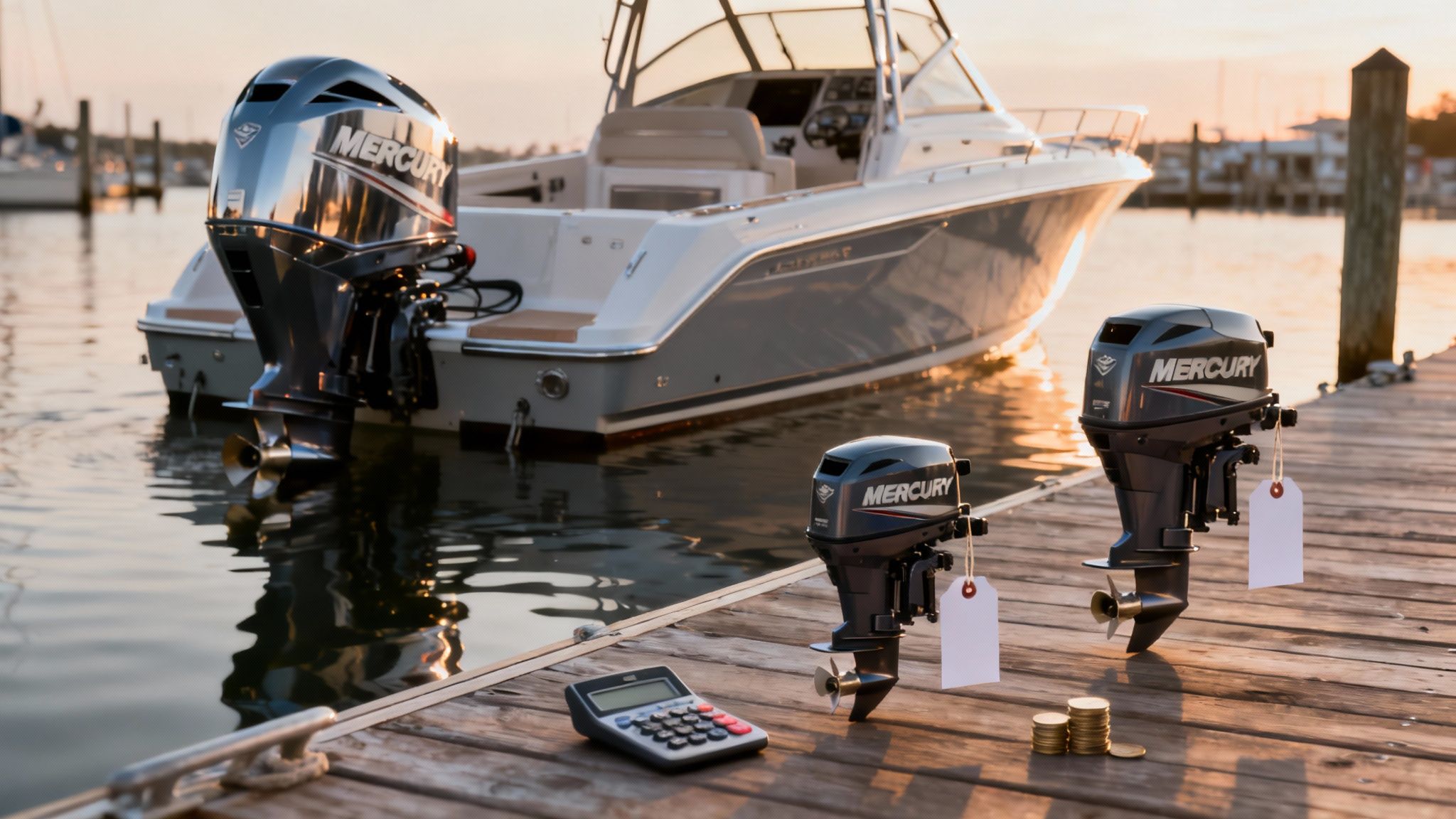
Thinking about buying a Mercury outboard? The first question on everyone's mind is always the same: "How much is it going to cost?" It’s a fair question, and the answer can range from around $1,500 AUD for a small, portable motor to well over $30,000 AUD for the serious high-horsepower models.
The final price tag really comes down to what you need—horsepower, features, and the tech packed inside all play a big part.
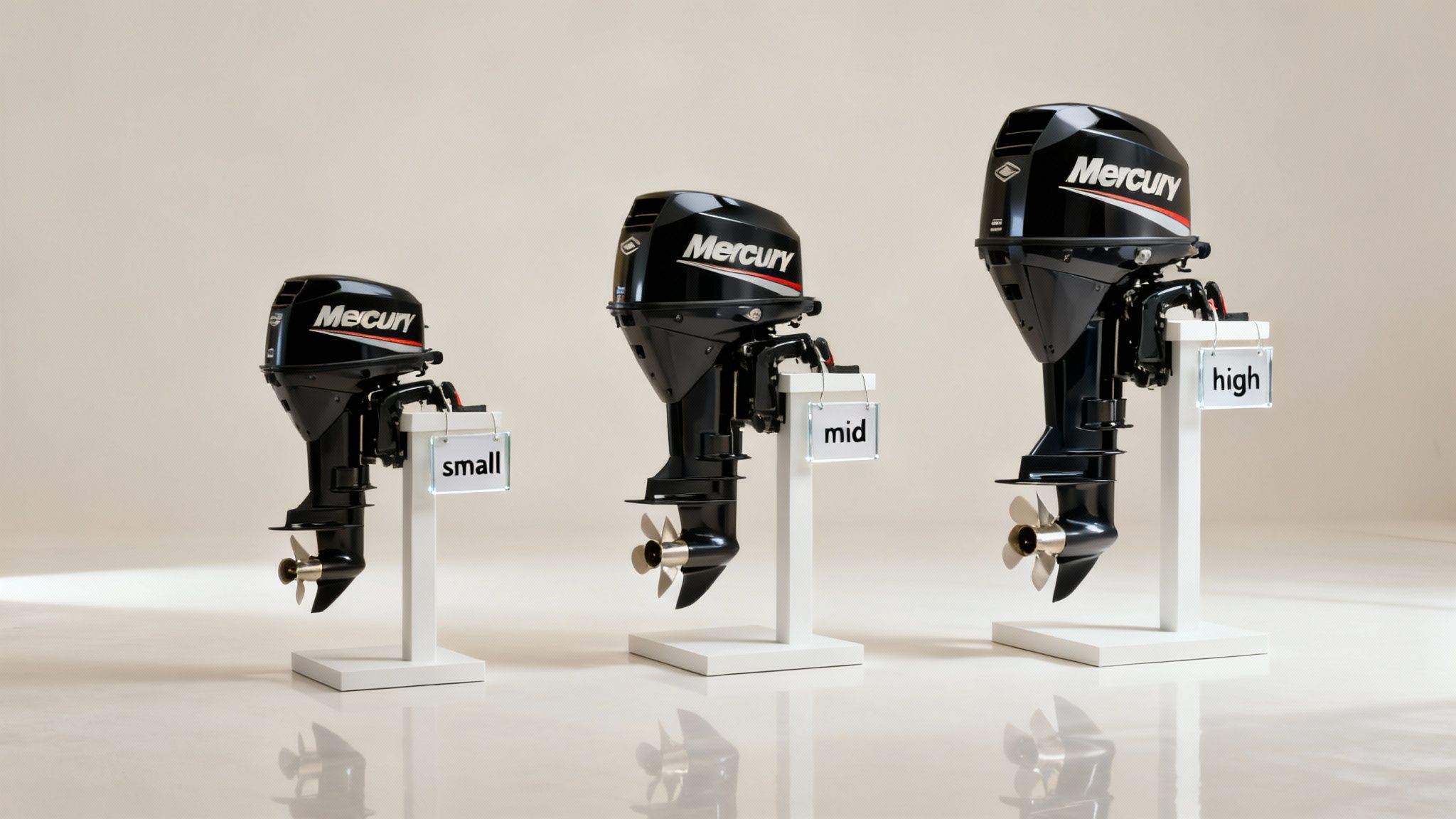
Whether you're fitting out a brand-new inflatable or giving your trusty old tinny a new lease on life, figuring out the budget is the first step. Mercury has built a rock-solid reputation for performance and reliability, which often means you’re looking at a premium price point. But as any seasoned boater will tell you, that investment pays off in the long run.
Here in Australia, Mercury is one of the most trusted names on the water, known for its powerful and innovative petrol outboards. Their range is massive, starting with little 2.5 horsepower kickers and going all the way up to absolute beasts for offshore rigs. They back their engineering with a hefty 6-year warranty, which says a lot about the confidence they have in their motors.
To get your head around the numbers, it helps to break them down by horsepower. While the final price will always vary between dealers and depend on the specific features you choose, this table gives you a solid starting point for your budget. Think of it as a quick-reference guide for new four-stroke models, before you factor in installation and rigging costs.
| Horsepower (HP) Range | Typical Use Case | Estimated Price Range (AUD) |
|---|---|---|
| 2.5 HP – 20 HP | Tenders, car toppers, small tinnies, inflatables | $1,500 – $5,000+ |
| 25 HP – 70 HP | Fishing boats, family runabouts, larger inflatables | $6,000 – $14,000+ |
| 75 HP – 115 HP | All-rounders, ski boats, medium offshore rigs | $15,000 – $22,000+ |
| 150 HP+ | Serious offshore fishing, performance boats | $25,000 – $60,000+ |
As you can see, there’s a Mercury for just about every boat and budget.
Breaking it down even further, each horsepower category is designed for a different kind of boating.
Portable Power (2.5 HP – 20 HP): This is your grab-and-go range. Perfect for tenders, small fishing boats, and inflatables. They’re light, easy to handle, and the most affordable way to get into the Mercury family.
Mid-Range Versatility (25 HP – 115 HP): This is the sweet spot for most recreational boaters. It’s the workhorse range that powers everything from family runabouts to dedicated fishing rigs, offering a fantastic balance of power, fuel efficiency, and modern features.
High-Performance Power (150 HP+): Now we're talking serious muscle. These motors are engineered for bigger offshore vessels and high-performance boats that demand maximum power, speed, and control in tough conditions.
When you’re weighing up your options, remember to look beyond the initial sticker price. While premium brands like Mercury have a higher upfront cost, it's worth exploring all your choices. For those seeking exceptional value for money, brands like Hidea offer a great mix of affordability and reliability. You can find some fantastic affordable outboard motors that deliver solid performance without breaking the bank.
Ever looked at two outboard motors with the same horsepower and wondered why their price tags are miles apart? The answer is always in the details. It's a bit like buying a new car—the base model gets you on the road, but it’s the optional extras and tech packages that shape the final price.
Horsepower is just the starting line. The real cost comes down to the technology, features, and configuration you choose for your motor.
Understanding these variables is the key to balancing what you need on the water with what your wallet can handle. A simple, no-frills motor is perfect for a small tinny, but for a serious offshore rig, you'll want an engine loaded with features.
The biggest price jumps usually come from how you control and operate the motor. These choices can easily add hundreds, or even thousands, of dollars to the final bill.
Beyond the basics, modern technology and outside market forces also play a big part in the prices you see at the dealership. Things like advanced digital controls, specialised gearcases for high-performance boats, and integrated smart gauges all add to the cost but deliver a far superior experience on the water.
Global supply chains are a huge factor, too. We’ve all felt it. Market data shows that Aussie boaters are feeling the pinch from things like rising aluminium prices and electronics shortages, which have stretched out lead times for new outboards. These supply issues put upward pressure on prices, especially for mid-range motors.
For many boaters, the sweet spot is often in the mid-range. A 20 HP outboard engine, for example, offers a fantastic balance of features and power without the premium price tag of the high-horsepower models. It’s all about matching the motor’s capabilities to what you actually do on the water.
When you start comparing premium brands like Mercury with value-focused options like Hidea, these features are where the price differences really show. Mercury often includes advanced tech as standard on its higher-end models, which justifies its premium position in the market. Meanwhile, Hidea delivers excellent value for money by focusing on robust, essential features without all the bells and whistles, offering a more affordable way to get on the water.
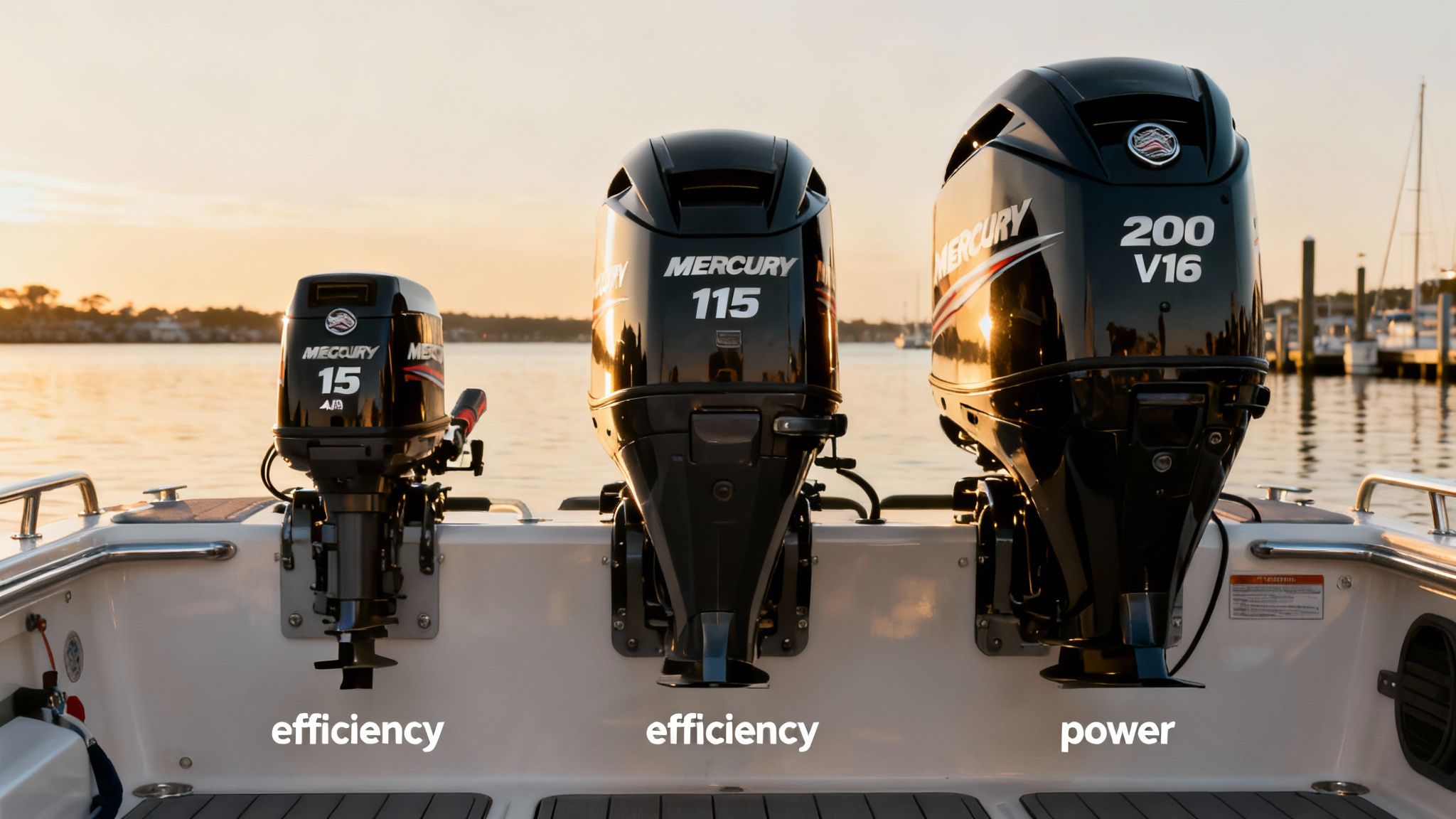
Alright, let's get past the general price ranges and talk about what really matters: how Mercury boat motor prices translate to actual on-water performance. The price tag on an outboard isn't just a random number; it's a direct reflection of the engine's engineering, the tech packed inside, and what it can do for you when you're out there.
By looking at a few of Mercury's most popular models, you can really see what you’re paying for. This is where the difference becomes clear between a motor that just pushes your boat along and one that genuinely makes every moment on the water better.
For the smaller boats in your life—think inflatables, tenders, and classic aluminium tinnies—the Mercury 15 HP FourStroke is an absolute gem. It’s light, genuinely portable, and built with reliability at its core. Its price reflects a smart, robust design focused on one thing: being incredibly efficient and easy to use.
No, it won't be setting any speed records, but that's not its job. Its performance is perfectly tuned for its purpose. You get a motor that fires up easily, runs quietly, and barely sips fuel, making it a brilliant and cost-effective partner for a bit of inshore fishing or exploring calm waterways.
If you're curious about eco-friendly power for smaller craft, our guide on the Mercury electric outboard dives into the latest options hitting the market.
Stepping up to the Mercury 115 HP FourStroke puts you squarely in the territory of true versatility. There’s a good reason this motor is a massive favourite for family runabouts and mid-sized fishing boats. That higher price tag is backed by a serious jump in power, speed, and some clever features.
This engine is engineered to give you the punchy acceleration you need for watersports, while still being impressively fuel-efficient when you're just cruising with the family. For instance, the Mercury 115 HP FourStroke can hit a top speed of around 37.8 knots at full throttle, using about 44 litres of fuel per hour. That balance of power and efficiency is precisely why it’s the go-to for boaters who need it all.
Here's something to keep in mind when comparing models: value is about much more than the initial purchase price. An engine's long-term fuel economy, its reputation for reliability, and how easy it is to service all play a huge role in its total cost of ownership. This is often where premium brands really justify their price over the budget options.
For the serious offshore angler or those with larger vessels, the Mercury 200 HP V6 FourStroke is a different beast altogether. It represents a major leap in performance and technology, and its price reflects the complex engineering needed to deliver that much power, day in and day out, in harsh saltwater conditions.
This motor isn't just about raw horsepower; it’s about how smoothly and efficiently it delivers that power. The premium price is driven by features you can actually feel:
This is the kind of refinement and performance that sets premium models apart. For dedicated boaters who demand the absolute best from their gear, the return on investment is tangible every time you push the throttle forward.
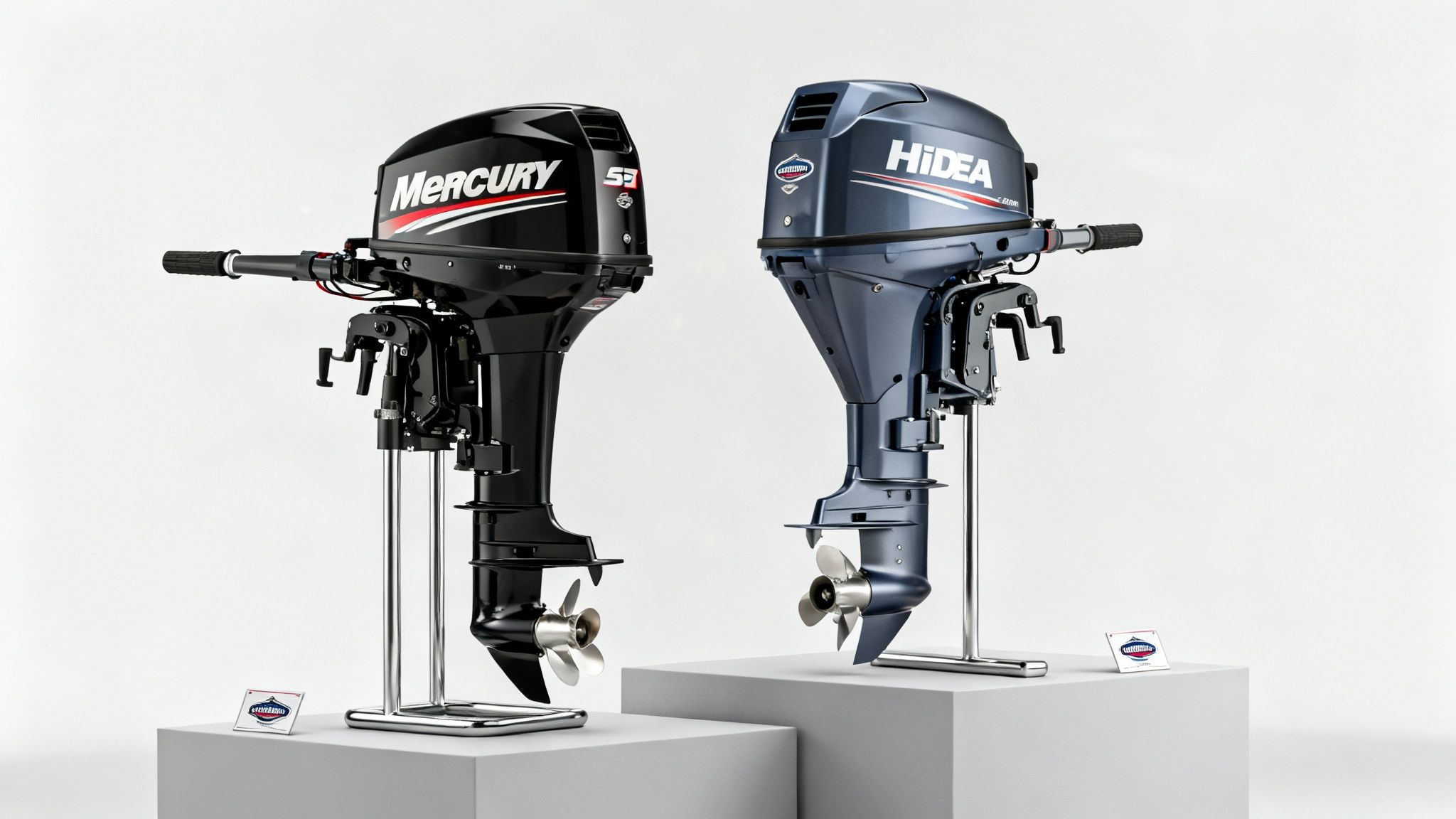
When you start looking into Mercury boat motor prices, it's only natural to stack them up against other brands. For many Aussie boaters, this leads to a classic dilemma: do you invest in a premium, globally known name like Mercury, or go for a value-focused alternative like Hidea, which has built a solid reputation for its outstanding value for money and affordability?
This isn't just about the initial sticker shock. It's a much deeper look into long-term value, the tech under the cowl, and what you’re really getting for your hard-earned money. Mercury's higher price tag often comes with advanced features and a massive service network, while Hidea makes a compelling argument for boaters who want a tough, reliable engine without draining their bank account.
The first thing you’ll notice when comparing Mercury and Hidea is the upfront cost. It’s a big difference. Hidea outboards are almost always priced significantly lower than a Mercury of the same horsepower. For a budget-savvy buyer, this can mean saving hundreds, sometimes even thousands, of dollars right off the bat.
That price gap can free up your budget for other important gear, like better electronics, top-notch safety equipment, or even a higher-quality boat hull. Hidea's game plan is to deliver dependable power and the features you actually need, making them a fantastic choice for anyone wanting solid performance without paying a premium for brand recognition or fancy tech.
This is where you start to see why Mercury commands a higher price. Their engines, especially in the mid to high horsepower range, are loaded with sophisticated technology that enhances the entire boating experience.
Mercury: You’ll often find features like Digital Throttle & Shift (DTS) for silky-smooth control, advanced fuel injection for better efficiency, and integrated SmartCraft gauges that feed you comprehensive engine data. It all adds up to a quieter, smoother, and more refined ride.
Hidea: The focus here is on proven, reliable tech. Their modern four-stroke models feature dependable Electronic Fuel Injection (EFI). While they might not have the same level of digital gadgetry as a Mercury, Hidea engines are celebrated for being tough workhorses that are simple to operate and maintain.
So, with Mercury, you’re paying for a feature-rich, high-tech package. With Hidea, you’re investing in solid, reliable power that gets the job done at an exceptional price point.
A good warranty brings peace of mind, and both brands have you covered here in Australia.
Mercury has one of the most extensive dealer and service networks in the country, hands down. No matter where your adventures take you—from the Kimberley to Tasmania—a certified Mercury technician is probably just around the corner. This huge network means parts and expert help are always easy to find, a major plus for those who travel or boat in remote areas.
Hidea also offers a solid warranty and is steadily growing its network of dealers and service agents. It might not be as widespread as Mercury's just yet, but the support is strong. Plus, their motors are often designed with simpler mechanics, which makes maintenance more straightforward for almost any workshop. For a deeper dive into what they offer, learning more about Hidea outboard motors and their value-driven approach is well worth your time.
To really put it all into perspective, let's line up two popular mid-range models. The exact specs will vary, but this table gives you a good snapshot of what you get from each brand.
| Feature | Mercury (e.g., 60 HP FourStroke) | Hidea (e.g., 60 HP EFI FourStroke) |
|---|---|---|
| Estimated Price | Higher initial purchase price | Significantly more affordable upfront |
| Core Technology | Advanced EFI, option for SmartCraft, DTS | Reliable Electronic Fuel Injection (EFI) |
| Key Selling Point | Integrated tech, brand reputation, performance | Exceptional value for money, affordability |
| Service Network | Extensive, Australia-wide dealer network | Growing network of service agents |
| Ideal User | Boaters wanting advanced features and brand trust | Budget-conscious boaters needing dependable power |
So, what's the verdict? It all comes down to your priorities. If you want the latest features, cutting-edge tech, and a massive service network, Mercury's premium price is easily justified. But if your main goal is to get a reliable, powerful, and affordable motor that gets you out on the water without any fuss, Hidea's value for money and affordability make it an undeniably strong choice.
When you’re looking at Mercury boat motors prices, the number on the price tag is just the first chapter of the story. A savvy boat owner knows the real cost of an outboard motor goes way beyond the initial purchase. To make a smart investment, you need to think about the total cost of ownership over the engine's entire life.
These ongoing, and often overlooked, expenses are crucial for getting your budget right. Factoring them in from the start ensures your new motor works for your finances for years to come, not just on the day you bring it home.
Unless you’re buying a small portable outboard you can clamp on yourself, you’ll need to account for professional installation and rigging. This isn't a simple bolt-on job. It involves hooking up steering, throttle controls, fuel lines, and all the electronics. The cost can vary a lot depending on your boat’s complexity, but it’s a vital expense for safety and performance.
On top of that, every new outboard needs a critical first service, usually after the first 20 hours of use. This initial check-up is non-negotiable—it’s essential for validating your warranty and making sure the engine has been broken in correctly.
Regular maintenance is the secret to a long and healthy engine life. We’re talking about annual services that include changing the engine oil, gear lube, filters, and spark plugs, plus inspecting the water pump impeller. These services keep your motor reliable and running efficiently.
Over time, you'll also need to replace parts due to normal wear and tear. Having easy access to quality components is a must. For those planning their long-term budget, you can find a comprehensive range of genuine Mercury outboard parts to keep your engine in top condition.
Fuel is easily one of the biggest ongoing expenses you'll face. While modern four-strokes are incredibly efficient, your consumption will depend on your horsepower, boat type, and how you drive it. A powerful V6 will naturally have a bigger appetite than a mid-range 60 HP model, so you need to factor this into your regular boating budget.
Finally, don't forget about insurance. Your premium will be influenced by the value of your new motor. A more expensive, high-horsepower engine will increase your insurance costs, so it’s always wise to get a quote beforehand to avoid any nasty surprises. By looking at all these factors, you get a complete and honest picture of the real cost.
Figuring out the world of Mercury boat motor prices and how they stack up against other brands really comes down to one simple question: what do you actually need out on the water? The "best" motor isn't always the one with the biggest horsepower or the fanciest gadgets. It's about finding the perfect fit for your specific boat, the adventures you have planned, and your budget over the long run.
Whether you're giving a beloved old boat a new lease on life or rigging up a brand-new inflatable, the choice is always a balance between the initial price tag and the ongoing value you get back.
Making a smart choice means weighing up a few key factors we've covered. It's about looking past the sticker price and thinking about what owning the motor will be like for years to come.
Premium Performance vs. Practical Value: A top-tier brand like Mercury backs up its price with cutting-edge tech, a massive service network, and seriously impressive performance. On the other hand, a brand like Hidea focuses on delivering incredible value with reliable, no-fuss engineering that makes boating more affordable for everyone.
Long-Term Reliability: Both Mercury and Hidea build motors you can depend on. Your decision here should really consider the warranty support and how easy it is to find a service agent in your local area. A strong service network offers real peace of mind, especially when you're exploring out-of-the-way spots.
Matching Power to Purpose: It's tempting to go for the biggest motor you can afford, but try to resist. Over-powering or under-powering your boat is a recipe for frustration. A motor that's perfectly sized for your vessel will give you better fuel economy, much better handling, and a far more enjoyable day on the water.
This decision tree infographic is a great way to visualise the key cost factors you'll face over the life of your motor, from the day you buy it to its ongoing care.
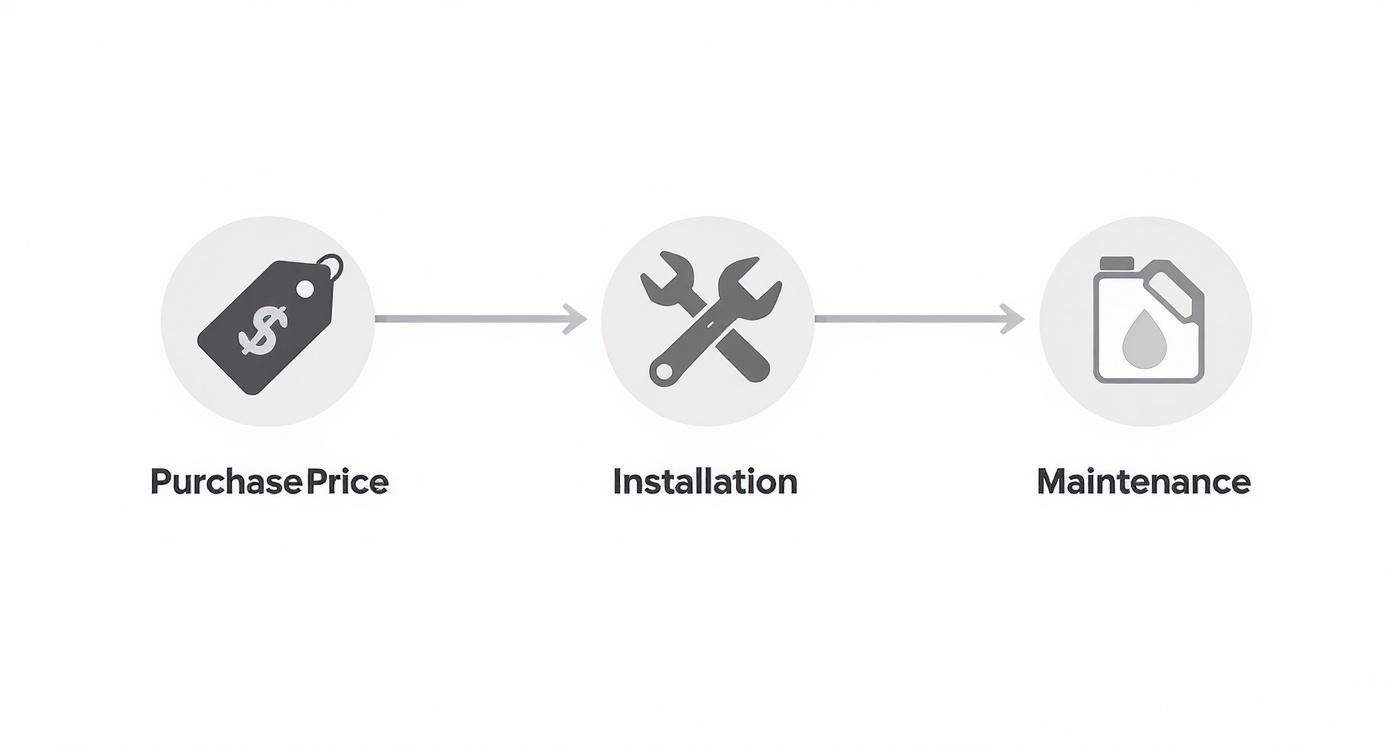
As you can see, the true cost is a mix of the initial purchase, getting it installed by a pro, and keeping up with consistent maintenance over time.
At the end of the day, the choice is a personal one. If you're a die-hard angler who needs a lightning-fast holeshot and integrated digital controls for a high-performance bass boat, then investing in a Mercury Pro XS is probably a no-brainer. You're paying for a specialised tool built to give you a competitive edge.
But if you’re just looking for a solid, dependable motor to power family trips on your inflatable, explore local estuaries, or act as a tender for your yacht, Hidea’s mix of affordability and proven reliability makes a very strong argument. It’s a straightforward, value-packed way to get on the water without cutting corners.
Your ideal motor is one that gets you out on the water confidently and fits comfortably within your budget, both now and in the future. It’s about maximising your enjoyment, not just your horsepower.
By taking a moment to think about your needs and comparing the real value each brand offers, you can pick an outboard that will give you years of reliable service and countless good times.
Ready to find the perfect inflatable boat and motor package? Easy Inflatables offers a fantastic range of Aerowave boats and Hidea outboards to create your ideal setup. Explore our customisable options and value-packed packages today.
Experience the ultimate freedom on the water with our top-quality inflatable boats and accessories. Easy Inflatables is your trusted partner, providing everything you need for a safe and unforgettable adventure.
At Easy Inflatables, we believe in empowering adventurers with high-quality inflatable solutions. Our commitment to durability and performance ensures that every product enhances your outdoor experiences.